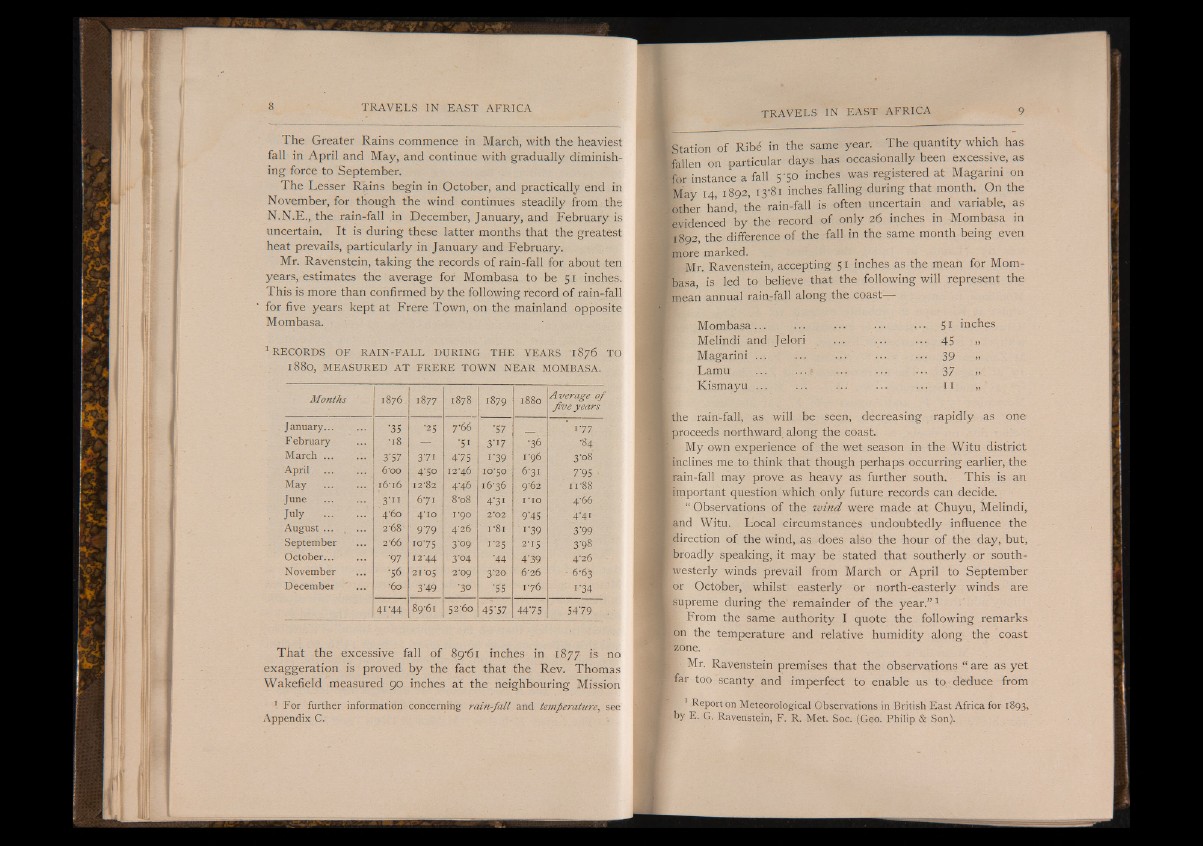
The Greater Rains commence in March, with the heaviest
fall in April and May, and continue with gradually diminishing
force to September.
The Lesser Rains begin in October, and practically end in
November, for though the wind continues steadily from the
N.N.E., the rain-fall in December, January, and February is
uncertain. It is during these latter months that the greatest
heat prevails, particularly in January and February.
Mr. Ravenstein, taking the records of rain-fall for about ten
years, estimates the average for Mombasa to be 51 inches.
This is more than confirmed by the following record of rain-fall
for five years kept at Frere Town, on the mainland opposite
Mombasa.
R e c o r d s o f r a i n - f a l l d u r i n g t h e y e a r s 1876 t o
1880, MEASURED AT FRERE TOWN NEAR MOMBASA.
Months 1876 1877 1878 1879 1880 Average o f
fiv e years
January... •35 ¡ ¡ ¡ ¡ I l 7 "66 '57 177
February 'Si 3' i 7 •36 H
March ... 3’57 371 475 i "39 1-96 3-08
April 6'cio 4-50 1246 10*50 6-31 7' 95
May ............... i6’i6 12*82 4-46 16-36 9'62 ix-88
June 3'i i 671 8-o8 « I 1*10 4-66
July ... ... 4 '6 o 4'xo 1-90 2*02 9"45 441
August ... , ... 2 -6 8 9 7 9 4-26 i - 8 i 1-39 3'99
September ... 2'66 10-75 3 '09 «V î£ | l| 2-15 3'98
October. '97 12-44 3'o4 '44 4 ’39 4-26
November •56 21'05 2-09 3-20 6 ' 2 Ó - 6-63
December ’ ... '6o 3"49 ■30 •SS 1-76 i '34
41-44 89-61 52'6o 45-57 44-75 5479
That the excessive fall of 89-61 inches in 1877 is no
exaggeration is proved by the fact that the Rev. Thomas
Wakefield measured 90 inches at the neighbouring Mission
1 For further information concerning rain-fall and temperature, see
Appendix C.
Station of Rib6 in the same year. The quantity which has
fallen on particular days has occasionally been excessive, as
for instance a fall 5 ’5© inches was registered at Magarini on
May 14, 1892, 13-81 inches falling during that month. On the
other hand, the rain-fall is often uncertain and variable, as
evidenced by the record of only 26 inches in Mombasa in
1892, the difference of the fall in the same month being even
more marked.
| Mr. Ravenstein, accepting 51 inches as the mean for Mom-
'basa, is led to believe that the following will represent the
mean annual rain-fall along the coast—
Mombasa ... ■ • ■ • • ■ • • ■ 51 inches
Melindi and Jelori ... ... ... 45 »
Magarini............................ 39 »
Lamu ... ...?................................... 37 „
Kismayu ... ... ... ... ... 11 „
the rain-fall, as will be seen, decreasing rapidly as one
proceeds northward along the coast.
I My own experience of the wet season in the Witu district
inclines me to think that though perhaps occurring earlier, the
: rain-fall may prove as heavy as further south. This is an
important question which only future records can decide.
I “ Observations of the wind were made at Chuyu, Melindi,
■and Witu. Local circumstances undoubtedly influence the
: direction of the wind, as does also the hour of the day, but,
broadly speaking, it may be stated that southerly or southwesterly
winds prevail from March or April to September
or October, whilst easterly or north-easterly winds are
.supreme during- the' remainder of the year.” 1
[ From the same authority I quote the following remarks
on the temperature and relative humidity along the coast
[ zone.
i Mr. Ravenstein premises that the observations “ are as yet
|far too scanty and imperfect to enable us to. deduce from
1 Report on Meteorological Observations in British East Africa for 1893,
’ by E. G. Ravenstein, F. R. Met. Soc. (Geo. Philip & Son).